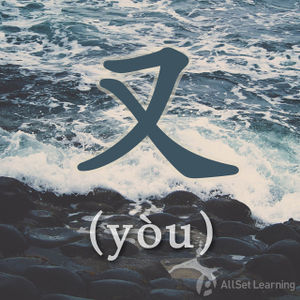Difference between revisions of "Expressing "both A and B" with "you""
m |
m (Text replacement - "Zhè gè" to "Zhè ge") |
||
| Line 20: | Line 20: | ||
* 他 <em>又</em> 高 <em>又</em> 帅。<span class="pinyin">Tā <em>yòu</em> gāo <em>yòu</em> shuài.</span><span class="trans">He is both tall and handsome.</span> | * 他 <em>又</em> 高 <em>又</em> 帅。<span class="pinyin">Tā <em>yòu</em> gāo <em>yòu</em> shuài.</span><span class="trans">He is both tall and handsome.</span> | ||
* 她 <em>又</em> 聪明 <em>又</em> 漂亮。<span class="pinyin">Tā <em>yòu</em> cōngmíng <em>yòu</em> piàoliang.</span><span class="trans">She is both smart and beautiful。</span> | * 她 <em>又</em> 聪明 <em>又</em> 漂亮。<span class="pinyin">Tā <em>yòu</em> cōngmíng <em>yòu</em> piàoliang.</span><span class="trans">She is both smart and beautiful。</span> | ||
| − | * 这 个 啤酒 <em>又</em> 好喝 <em>又</em> 便宜。<span class="pinyin">Zhè | + | * 这 个 啤酒 <em>又</em> 好喝 <em>又</em> 便宜。<span class="pinyin">Zhè ge píjiǔ <em>yòu</em> hǎo hē <em>yòu</em> piányí.</span><span class="trans">This beer is both good-tasting and cheap.</span> |
* 他 <em>又</em> 丑 <em>又</em> 笨。<span class="pinyin">Tā <em>yòu</em> chǒu <em>yòu</em> bèn.</span><span class="trans">He is both ugly and stupid.</span> | * 他 <em>又</em> 丑 <em>又</em> 笨。<span class="pinyin">Tā <em>yòu</em> chǒu <em>yòu</em> bèn.</span><span class="trans">He is both ugly and stupid.</span> | ||
* 这 房间 <em>又</em> 大 <em>又</em> 亮。<span class="pinyin">Zhè fángjiān <em>yòu</em> dà <em>yòu</em> liàng.</span><span class="trans">This apartment is both big and bright.</span> | * 这 房间 <em>又</em> 大 <em>又</em> 亮。<span class="pinyin">Zhè fángjiān <em>yòu</em> dà <em>yòu</em> liàng.</span><span class="trans">This apartment is both big and bright.</span> | ||
* 你们 老板 <em>又</em> 年轻 <em>又</em> 有钱。<span class="pinyin">Nǐmen lǎobǎn <em>yòu</em> niánqīng <em>yòu</em> yǒu qián.</span><span class="trans">Your boss is both young and rich.</span> | * 你们 老板 <em>又</em> 年轻 <em>又</em> 有钱。<span class="pinyin">Nǐmen lǎobǎn <em>yòu</em> niánqīng <em>yòu</em> yǒu qián.</span><span class="trans">Your boss is both young and rich.</span> | ||
| − | * 这 个 苹果 <em>又</em> 红 <em>又</em> 甜。<span class="pinyin">Zhè | + | * 这 个 苹果 <em>又</em> 红 <em>又</em> 甜。<span class="pinyin">Zhè ge píngguǒ <em>yòu</em> hóng <em>yòu</em> tián.</span><span class="trans">This apple is both red and sweet.</span> |
| − | * 这 个 孩子 <em>又</em> 瘦 <em>又</em> 小。<span class="pinyin">Zhè | + | * 这 个 孩子 <em>又</em> 瘦 <em>又</em> 小。<span class="pinyin">Zhè ge háizi <em>yòu</em> shòu <em>yòu</em> xiǎo.</span><span class="trans">This child is both thin and small.</span> |
* 小狗 <em>又</em> 可爱 <em>又</em> 听话。<span class="pinyin">Xiǎo gǒu <em>yòu</em> kě'ài <em>yòu</em> tīnghuà.</span><span class="trans">The puppy is both cute and obedient.</span> | * 小狗 <em>又</em> 可爱 <em>又</em> 听话。<span class="pinyin">Xiǎo gǒu <em>yòu</em> kě'ài <em>yòu</em> tīnghuà.</span><span class="trans">The puppy is both cute and obedient.</span> | ||
* 这 种 东西 真 是 <em>又</em> 贵 <em>又</em> 难吃。<span class="pinyin">Zhè zhǒng dōngxī zhēn shì <em>yòu</em> guì <em>yòu</em> nán chī.</span><span class="trans">This thing really is both expensive and bad-tasting.</span> | * 这 种 东西 真 是 <em>又</em> 贵 <em>又</em> 难吃。<span class="pinyin">Zhè zhǒng dōngxī zhēn shì <em>yòu</em> guì <em>yòu</em> nán chī.</span><span class="trans">This thing really is both expensive and bad-tasting.</span> | ||
Revision as of 02:52, 17 August 2015
-
Level
-
Similar to
-
Used for
-
Keywords
In English, we often use descriptive words, and more than not, use multiple at a time. The character 又 (yòu) can be used to give two qualities or features to something. Using 又 (yòu) and the structure is like saying that something is "both ... and ... " in English.
Structure
The structure in Chinese is:
Subject + 又 + Adjective 1 + 又 + Adjective 2
Unlike in English, the two words can't contrast in feeling. It is important to note they must both be bad or both be good.
Examples
- 他 又 高 又 帅。He is both tall and handsome.
- 她 又 聪明 又 漂亮。She is both smart and beautiful。
- 这 个 啤酒 又 好喝 又 便宜。This beer is both good-tasting and cheap.
- 他 又 丑 又 笨。He is both ugly and stupid.
- 这 房间 又 大 又 亮。This apartment is both big and bright.
- 你们 老板 又 年轻 又 有钱。Your boss is both young and rich.
- 这 个 苹果 又 红 又 甜。This apple is both red and sweet.
- 这 个 孩子 又 瘦 又 小。This child is both thin and small.
- 小狗 又 可爱 又 听话。The puppy is both cute and obedient.
- 这 种 东西 真 是 又 贵 又 难吃。This thing really is both expensive and bad-tasting.



